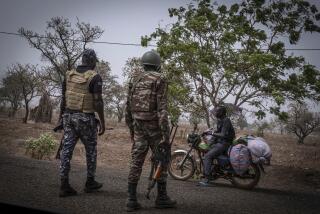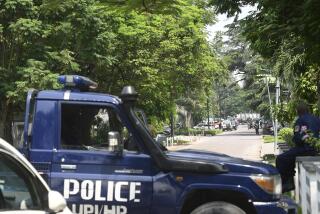Libyan rebels firmly in control in mountainous west
Moammar Kadafi’s forces came by the thousands with tanks, armored vehicles and rocket launchers to quell an uprising in the forbidding Western Mountains region of Libya.
They left Zintan last month in a rout, rebels and Western journalists say, running through the woods as residents of the rebellious city pursued them using weapons and equipment seized from troops. It was a decisive battle that exposed the far western flank of Kadafi’s security forces.
“What happened here was a beautiful thing,” Milad Lameen, a 59-year-old former Libyan Airlines official and businessman who now serves as a political leader in Zintan, said in an interview conducted over Skype. “The equation was absolutely against us. But his troops and his mercenaries did not have a winning cause. We have a good cause.”
While international attention has been focused on the rebel-controlled stronghold of Benghazi in eastern Libya and the besieged coastal city of Misurata, tens of thousands of Libyans have taken control of a mountainous region stretching about 100 miles from the Tunisian border toward the capital, Tripoli. The provisional government in the far west is in touch with the rebels in Benghazi but not under their authority.
On Thursday, Kadafi’s forces suffered another blow in the Western Mountains region when rebels took over the Wazin-Dehibat border crossing with Tunisia, giving them access to supplies to sustain their enclave. The Libyan government denied that the border post had fallen, even as photographs show protesters there waving the pre-Kadafi flag of Libya.
Officials loyal to Kadafi’s regime say small areas in the mountains are under the control of armed Islamic militants. The rebels deny that assertion, and several foreign journalists who have visited the region have largely confirmed their account.
The story of the Western Mountains, the rebels say, shows how Libyans pursuing peaceful protests became well-armed warriors because of the violent response and missteps of Kadafi’s regime. Although the fighting in the east has ground into a standoff, rebels in the west have been making advances.
“What ignited this revolution were all the bad deeds Kadafi has been committing for 42 years,” Lameen said. “What delayed the revolution was the oppressive nature of the regime.”
The people of the region — a mixture of Arab and ethnic Berber, or Amazigh, tribes — have long been at odds over water and land rights. Kadafi deftly pitted them against one another in an attempt to maintain his hold on power, they say.
But for now, they have united in opposing him, Lameen said.
The uprising in the Western Mountains began shortly after the revolt erupted in mid-February in Benghazi, now home to the rebel transitional government. Lameen said authorities triggered the uprising when they came to Zintan to recruit 4,000 tribesmen to help crush the rebels in the east.
“We told them, ‘We cannot provide you with recruits to fight Libyan citizens,’” Lameen said.
Insulted by the proposal, a small group of protesters gathered in Zintan and began chanting slogans against Kadafi. The protest quickly grew.
“More and more people started coming from all sides of town to the city square,” Lameen said, turning it into a version of Cairo’s Tahrir Square, the focal point of the Egyptian uprising that had swept away Hosni Mubarak’s regime about a week earlier.
The next day Kadafi’s troops entered the city, opening fire with live ammunition and killing several people before leaving.
Troops returned soon afterward, driving the Toyota Tundra sport utility vehicles associated with the brigade overseen by Kadafi’s son Khamis. Residents counterattacked and drove them back, Lameen said.
Kadafi next offered hundreds of thousands of dollars to people to drop their political demands. Instead Zintan residents, famed as warriors, began setting up checkpoints and collecting weapons, in some cases seizing government antiaircraft guns.
“Everybody here is a fighter,” Lameen said. “We don’t have an exact number of fighters. This is a civilian movement. Before, we were not organized. Now, we are very organized.”
Kadafi’s forces attempted again to crush the local uprising March 19 and 20. According to news accounts and rebels, troops returned with tanks, antiaircraft guns and rapid-firing Grad rocket launchers. But they traveled in one lengthy 4-mile-long convoy that was vulnerable to an ambush.
The locals obliged, attacking the military vehicles and sending the soldiers fleeing into the woods, Lameen said, in an account largely verified in reports by several European journalists in the enclave at the time.
“People started fighting Kadafi with whatever they had,” Lameen said, echoing the rebels’ tendency of lumping together government forces under the Libyan leader’s name. “As the soldiers fled into the woods, we fired on them. We killed hundreds of them.”
The rebels captured not only weapons, but also fuel and food that gave them breathing room. Now they’ve gone from defending themselves to launching raids. This week, video posted on the Internet showed the first graduating class of the National Army of Zintan. Uniformed soldiers were shown marching in formation as civilians watched.
“As we talk now, we’re engaging Kadafi,” Lameen said. “The moment you attack they’re afraid. They run away and you get more weapons.”
More to Read
Start your day right
Sign up for Essential California for news, features and recommendations from the L.A. Times and beyond in your inbox six days a week.
You may occasionally receive promotional content from the Los Angeles Times.






